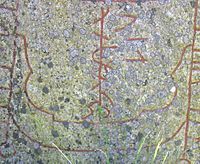Bind rune

Abind runeorbindrune(Icelandic:bandrún) is aMigration PeriodGermanicligatureof two or morerunes.They are extremely rare inViking Ageinscriptions, but are common in earlier (Proto-Norse) and later (medieval) inscriptions.[1]
On some runestones, bind runes may have been ornamental and used to highlight the name of the carver.[2]
Description
There are two types of bind runes. Normal bind runes are formed of two (or rarely three) adjacent runes which are joined together to form a single conjoinedglyph,usually sharing a common vertical stroke (seeHaddaexample below).[3]Another type of bind rune called a same-stave rune, which is common in Scandinavian runic inscriptions but does not occur at all inAnglo-Saxon runic inscriptions,is formed by several runic letters written sequentially along a long common stemline (seeþ=r=u=t=a=ʀ= =þ=i=a=k=nexample shown in image).[4]In the latter cases the long bind rune stemline may be incorporated into an image on the rune stone, for example as a ship's mast on runestonesSö 158at Ärsta andSö 352in Linga,Södermanland,Sweden,or as the waves under a ship onDR 220in Sønder Kirkeby,Denmark.[4]
Examples
Elder futhark
Examples found inElder Futharkinscriptions include:
- StackedTiwaz runes:Kylver Stone,Seeland-II-C
- Gebô runescombined with vowels:Kragehul I
- The syllableingwritten as a ligature ofIsazandIngwaz(the so-called "lantern rune" ).[5]
Anglo-Saxon Futhorc
Bind runes are not common in Anglo-Saxon inscriptions, but double ligatures do sometimes occur, and triple ligatures may rarely occur. The following are examples of bind-runes that have been identified in Anglo-Saxon runic inscriptions:[6][7]


- The wordgebiddaþis written with a ligatured doubleᛞ(dd) on the Thornhill III rune-stone
- The nameHaddais written with a ligatured doubleᛞ(dd) on the Derbyshire bone plate
- The wordbroþeris written with a ligaturedᛖandᚱ(er) on some Northumbrianstycas
- The Latin wordmeusis written asmæuswith a ligaturedᛗandᚫ(mæ) on the Whitby comb
- The inscription[h]ring ic hatt[æ]( "ring I am called" ) is written with a ligaturedᚻandᚪ(ha) on the Wheatley Hill finger-ring
- The names of the evangelists,Mat(t)[h](eus)andMarcusare both written with a ligaturedᛗandᚪ(ma) onSt Cuthbert's coffin
- The nameDeringmay be written with a triple ligaturedᛞ,ᛖandᚱ(der) on the Thornhill III rune-stone (this reading is not certain)
- The wordsefais written with a ligaturedᚠandᚪ(fa) on the right side of theFranks Casket
- Double ligatured runesᛖᚱ(er),ᚻᚪ(ha) andᛞᚫ(dæ) occur in the cryptic runic inscription on a silver knife mount at theBritish Museum
- The wordgægogæon theUndley bracteateis written with ligaturedᚷandᚫ(gæ) andᚷandᚩ(go)
- A ligaturedᚾandᛏ(nt) occurs in the wordglæstæpontolon a cryptic inscription on a silver ring from Bramham Moor in West Yorkshire
- A triple ligatureᛞ,ᛗandᚩ(dmo) occurs on a broken amulet found near Stratford-upon-Avon in 2006. This is the only known certain Anglo-Saxon triple bind rune. There is possibly a faintᛖ,ᛞ(ed) bind rune on the reverse of the amulet.[8]
- The name Ecgbeorht engraved on an armband from theGalloway Hoardis writteneggbrectwith ligaturedᛖandᚳ(ec), and the finalᛏ(t) added above the final letter
- The otherwise unattested Anglo-Saxon name Eadrufᛖᚪᛞᚱᚢᚠis inscribed on a gold Latin cross pendant, with ligaturedᛞandᚱ(dr) and probable ligaturedᛖandᚪ(ea)[9]
Modern use
- TheBluetoothlogo
 merges the runes analogous to the modernLatin alphabetlettershandb;ᚼ(Hagall) andᛒ(Berkanan) together, forming a bind rune. The two letters form the initials 'H B', alluding to theDanishking andvikingraiderHarald Bluetooth,for whom Bluetooth was named.
merges the runes analogous to the modernLatin alphabetlettershandb;ᚼ(Hagall) andᛒ(Berkanan) together, forming a bind rune. The two letters form the initials 'H B', alluding to theDanishking andvikingraiderHarald Bluetooth,for whom Bluetooth was named. - The former logo ofThor Steinarfeatured a combination of a*tiwaz rune(ᛏ) and a*sowilo runeᛋ.This logo caused controversy as the runes were so combined that a part of the logo became very similar to the insignia of theSchutzstaffel.
Gallery
-
Theaand theþrunes in ligature on theRök runestone
-
A bind rune for the wordrunaʀon theSønder Kirkeby Runestonein Denmark
See also
References
- ^Enoksen, Lars Magnar (1998).Runor: historia, tydning, tolkning,p. 84. Historiska Media, Falun.ISBN91-88930-32-7
- ^MacLeod, Mindy (2006), "Ligatures in Early Runic and Roman Inscriptions", in Stocklund, Marie; et al. (eds.),Runes and Their Secrets: Studies in Runology,Copenhagen: Museum Tusculanum Press, p. 194,ISBN87-635-0428-6
- ^Elliott, R. W. V. (1980).Runes.Manchester University Press. p. 22.ISBN0-7190-0787-9.
- ^abMacLeod, Mindy (2002).Bind-Runes: An Investigation of Ligatures in Runic Epigraphy.Uppsala University.pp. 16–18, 158–59, 162–163.ISBN91-506-1534-3.
- ^Richard Lee Morris,Runic and Mediterranean Epigraphy,1988,p. 130.
- ^Elliott, R. W. V. (1980).Runes.Manchester University Press. pp. 87, 105.ISBN0-7190-0787-9.
- ^Page, Raymond I.(2006).An Introduction to English Runes.Boydell Press. pp. 48, 163, 169, 172.ISBN0-85115-946-X.
- ^"Amulet WAW-4CA072".Portable Antiquities Scheme.6 September 2010.Retrieved2013-01-06.
- ^"Penndant DUR-B62F57".Portable Antiquities Scheme.23 June 2020.Retrieved2021-01-10.




